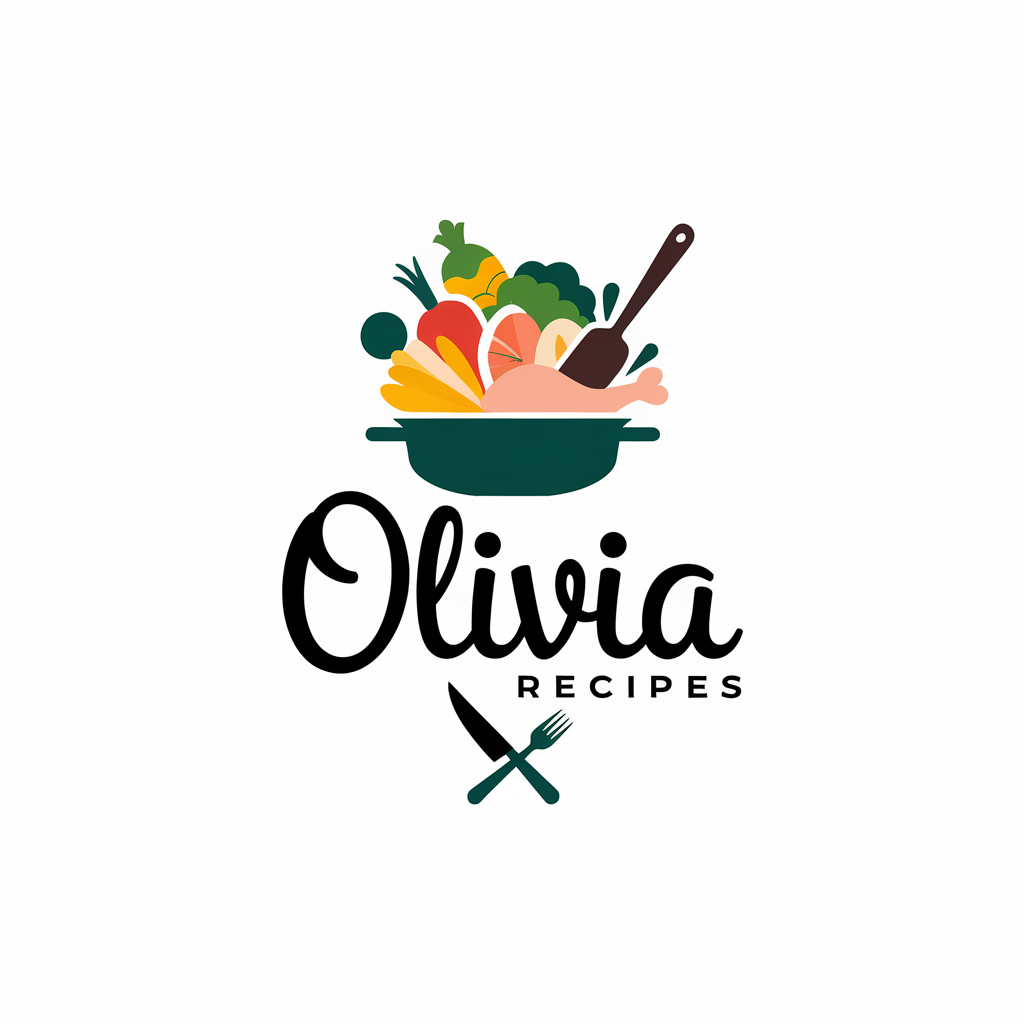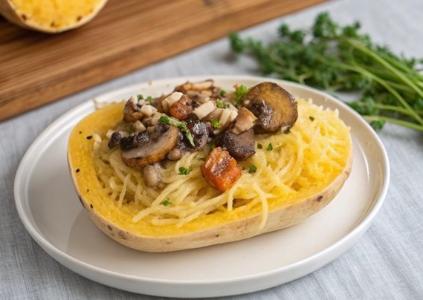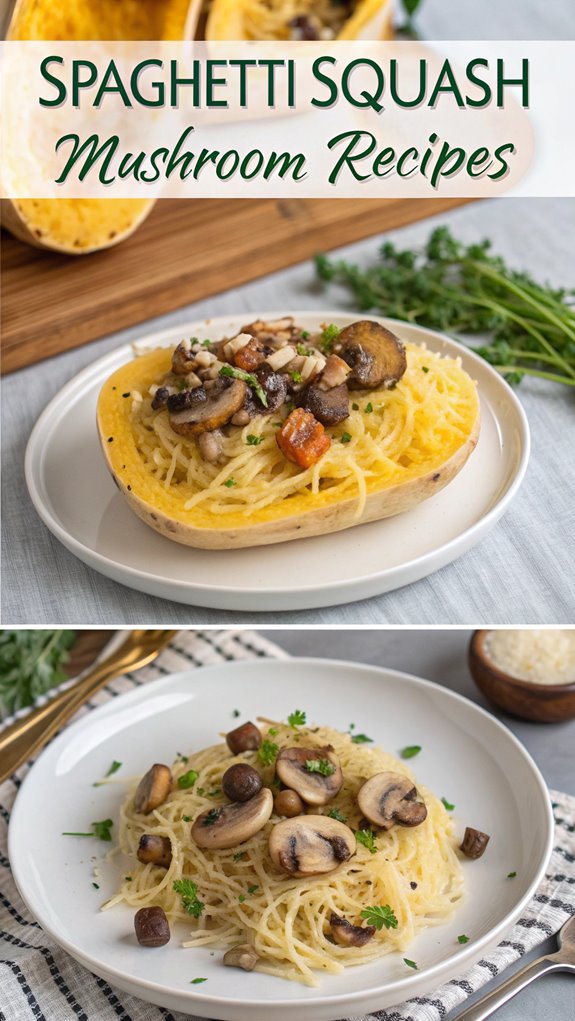Imagine serving a warm bowl of spaghetti squash tossed with sautéed mushrooms, garlic, and a sprinkle of fresh herbs—it’s a dish that not only satisfies but also nourishes. You might find the combination surprisingly versatile, easily adapting to your dietary needs while still feeling indulgent. But what makes this pairing truly special is the way the flavors meld together and elevate simple ingredients into something memorable. Curious about how to create these dishes or perhaps enthusiastic to learn some new variations? Let’s explore the possibilities that spaghetti squash and mushrooms can offer.
Why You’ll Love This Recipe
One of the best things about this spaghetti squash mushroom recipe is its incredible versatility. You can easily customize it to suit your taste preferences or dietary needs. This dish is a fantastic low-calorie alternative to traditional pasta, packed with nutrients.
Here’s why you’ll love it:
- Nutritional Benefits: Spaghetti squash is rich in fiber and essential vitamins like vitamin C and beta-carotene, which help protect your cells. It supports colon health and can lower cancer risks. Additionally, its low-calorie nature aids in weight management, making it an excellent choice for those looking to maintain a healthy weight.
- Easy to Cook: Cooking spaghetti squash is simple. Once cooked, its flesh transforms into spaghetti-like strands, making it a fun and unique base for various sauces.
- Flavorful Combinations: Adding mushrooms not only enhances the taste but also boosts heart health. Plus, their earthy flavor pairs well with the mild sweetness of the squash.
- Visual Appeal: You can serve the dish in its shell for a beautiful presentation.
- Diet-Friendly: This recipe can be adjusted for vegan diets by skipping cheese, making it accessible for everyone.
Enjoy making this nutritious and versatile meal that’s sure to please!
History
Exploring the history of spaghetti squash and mushrooms reveals a rich tapestry of culinary traditions.
- Spaghetti Squash: This vegetable originates from North America, particularly the United States and Mexico. It became popular in Italian cuisine as a healthier alternative to traditional pasta. The main ingredients in many recipes showcase spaghetti squash’s versatility and ability to absorb flavors.
- Mushrooms: Mushrooms have been consumed globally for thousands of years. Various species, like button, maitake, and oyster mushrooms, have found their way into countless cuisines.
- Cooking Techniques:
- Roasting enhances the flavors of spaghetti squash.
- Sautéing, a technique from France, is ideal for mushrooms and garlic.
- Microwaving offers a quick cooking option for spaghetti squash.
- Baking and stir-frying are also common methods, influenced by both historical cooking practices and modern adaptations.
- Culinary Evolution: Today, spaghetti squash mushroom recipes cater to vegetarian and gluten-free diets. They reflect seasonal ingredient usage and often blend traditional techniques with contemporary tastes.
This historical context enriches your understanding of how these ingredients and methods evolved, helping you appreciate the recipes even more.
Recipe
Spaghetti squash is a versatile vegetable that makes for a delicious and healthy alternative to traditional pasta. Combining it with sautéed mushrooms creates a hearty dish that is both satisfying and packed with flavor. The natural sweetness of the spaghetti squash pairs wonderfully with the earthy tones of the mushrooms, enhanced by aromatic garlic and olive oil. This recipe is not only simple to make but also allows for customization with various herbs and additional vegetables to suit your personal taste. Additionally, the squash has a mild flavor that absorbs the surrounding ingredients, making it a perfect canvas for this dish.
To prepare this dish, you’ll need to begin by cooking the spaghetti squash. There are several methods to choose from, such as microwaving, roasting in the oven, or boiling, depending on your preference and available time. Once the squash is cooked and shredded, it will be combined with a savory mushroom mixture, creating a delightful meal that’s perfect for any occasion. This recipe is also suitable for those following special diets, making it an excellent option for gatherings.
Ingredients:
- 1-2 pounds spaghetti squash
- 1-2 tablespoons olive oil
- 1-2 cups mushrooms (button, portabella, or mixed)
- 2-4 cloves garlic, minced
- Optional: onions, herbs, cheese
Cooking Instructions:
- Preheat your oven to 400°F (if roasting) or prepare your microwave or pot for cooking the spaghetti squash. Cut the squash in half lengthwise and scrape out the seeds with a spoon.
- If roasting, drizzle the cut side of the squash with olive oil and place it cut side down on a baking sheet. Roast for about 30-40 minutes or until tender. If microwaving, place the squash cut side down in a microwave-safe dish with a bit of water, cover, and microwave for 10-15 minutes, checking for tenderness. For boiling, place whole squash in boiling water and cook for 20-30 minutes until soft.
- While the squash is cooking, heat the olive oil in a skillet over medium heat. Add the minced garlic and sauté for 1 minute until fragrant. Add the mushrooms and cook until they are golden brown, about 5-7 minutes.
- Once the squash is cooked, use a fork to shred the flesh into spaghetti-like strands. Combine the shredded squash with the sautéed mushroom mixture in the skillet. Mix well and add any optional ingredients, such as onions or herbs, to taste.
- Serve hot, garnished with cheese, toasted pine nuts, or fresh basil if desired.
Extra Tips:
To enhance the flavor of your dish, consider adding a splash of lemon juice or a sprinkle of red pepper flakes for a little heat. Experiment with different types of mushrooms or additional vegetables like bell peppers or spinach to create your own unique variation. If you prefer a saucier dish, feel free to stir in some marinara sauce or top it with your favorite pasta sauce. Enjoy your delicious spaghetti squash mushroom creation!
Final Thoughts
When it comes to enjoying a healthy and satisfying meal, spaghetti squash with mushrooms stands out as a fantastic option. This dish is not only low in calories, with just 42 calories per cup, but it also provides a good source of fiber and essential vitamins. Additionally, spaghetti squash is a good source of fiber, providing 21% of the Daily Value.
Here are some key points to reflect on:
- Nutritional Benefits: Spaghetti squash is rich in vitamins C and B6, along with minerals like potassium and manganese. However, be mindful of sodium levels, as the dish can be high in salt.
- Cooking Techniques: Roasting your squash at 425°F for 30-40 minutes guarantees tenderness. Sauté mushrooms and onions in olive oil for added flavor, and think about deglazing with white wine.
- Flavor Enhancements: Fresh herbs, such as sage, and cheeses like Parmesan can elevate your dish. Adding toasted pine nuts or a drizzle of truffle oil can introduce delightful textures and flavors.
- Recipe Variations: You can easily adapt this dish to be vegetarian or vegan by omitting cheese and experimenting with different proteins, like shrimp or low-fat cottage cheese.
FAQ
If you have questions about preparing spaghetti squash with mushrooms, you’re not alone. Here are some common queries and their answers.
How do I prepare spaghetti squash?
Cut the squash in half lengthwise and scrape out the seeds. You can either microwave it on high for about 10 minutes or roast it in the oven until tender. After cooling, use a fork to shred the flesh into strings. One-pan preparation simplifies cooking and cleanup.
What types of mushrooms should I use?
You can use button mushrooms, baby bella mushrooms, or a mix of fresh and dried varieties. Sauté them in olive oil with garlic until golden brown.
How do I combine them?
Mix your sautéed mushrooms with the cooked spaghetti squash. For extra flavor, consider adding parmesan cheese, onions, tomatoes, or pine nuts.
What are the nutritional benefits?
Spaghetti squash is low in calories and high in fiber, vitamins, and pantothenic acid. It’s a healthier alternative to traditional pasta, offering more nutrients and fewer calories.
Can I modify the recipe?
Absolutely! Feel free to experiment with different herbs, cheeses, or flavor enhancers like beef broth or coconut aminos.



